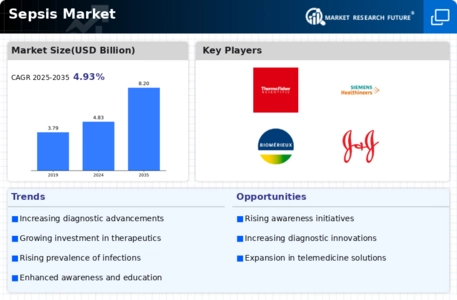Rising Incidence of Sepsis
The increasing incidence of sepsis is a primary driver of the Sepsis Market. According to recent estimates, sepsis affects millions of individuals annually, leading to significant morbidity and mortality. The World Health Organization indicates that sepsis is a leading cause of death in hospitals, with a mortality rate that can exceed 30 percent in severe cases. This alarming trend necessitates enhanced diagnostic and therapeutic solutions, thereby propelling the demand for sepsis-related products and services. As healthcare systems strive to improve patient outcomes, investments in sepsis management are likely to rise, further stimulating the Sepsis Market. The growing awareness of sepsis among healthcare professionals and the public also contributes to increased screening and early intervention, which may lead to a more robust market landscape.
Growing Awareness and Education
The growing awareness and education surrounding sepsis are crucial drivers of the Sepsis Market. Healthcare professionals are increasingly educated about the signs and symptoms of sepsis, leading to earlier diagnosis and treatment. Public health campaigns aimed at educating the general population about sepsis are also gaining momentum, which may result in more individuals seeking timely medical attention. This heightened awareness is likely to contribute to an increase in sepsis cases being identified and treated effectively, thereby driving demand for sepsis-related products and services. As educational initiatives continue to expand, the Sepsis Market is expected to benefit from a more informed patient population and a healthcare workforce equipped to manage sepsis more effectively.
Aging Population and Comorbidities
The aging population, coupled with the prevalence of comorbidities, is a significant factor influencing the Sepsis Market. As individuals age, their immune systems often weaken, making them more susceptible to infections that can lead to sepsis. Additionally, the presence of chronic conditions such as diabetes, heart disease, and respiratory disorders further increases the risk of sepsis. According to demographic studies, the proportion of older adults is projected to rise, which may lead to a corresponding increase in sepsis cases. This demographic shift is likely to drive demand for sepsis management solutions, as healthcare providers seek to address the unique challenges posed by this vulnerable population. Consequently, the Sepsis Market is poised for growth as it adapts to the needs of an aging society.
Government Initiatives and Funding
Government initiatives aimed at combating sepsis are playing a pivotal role in shaping the Sepsis Market. Various health authorities are implementing programs to raise awareness, improve early detection, and enhance treatment protocols for sepsis. Funding for research and development in sepsis-related technologies is also on the rise, as governments recognize the need to address this critical health issue. For instance, initiatives that promote collaboration between public health organizations and private sector stakeholders are fostering innovation in sepsis diagnostics and therapeutics. This increased financial support is likely to accelerate the development of new products and services within the Sepsis Market, ultimately leading to improved patient care and outcomes.
Technological Innovations in Treatment
Technological advancements in treatment modalities are significantly influencing the Sepsis Market. Innovations such as novel antibiotics, immunotherapies, and advanced fluid resuscitation techniques are emerging as critical components in the management of sepsis. The introduction of rapid diagnostic tools, which can identify pathogens within hours, is transforming treatment protocols and improving patient outcomes. Furthermore, the development of personalized medicine approaches, tailored to individual patient profiles, is gaining traction. These advancements not only enhance the efficacy of treatments but also reduce the length of hospital stays, thereby lowering healthcare costs. As a result, the Sepsis Market is expected to witness substantial growth, driven by the continuous evolution of treatment technologies that address the complexities of sepsis management.


















Leave a Comment